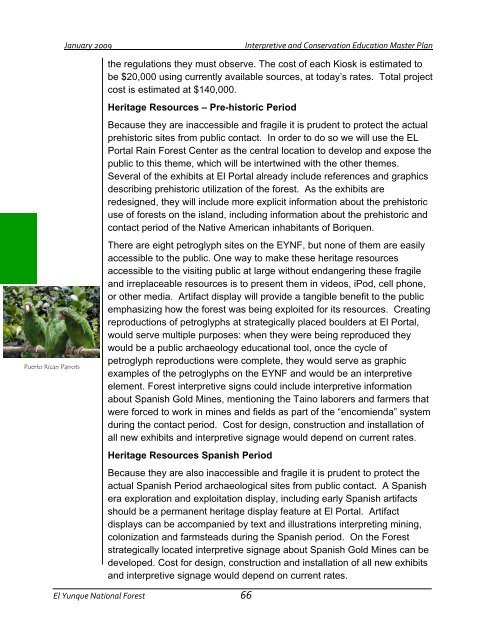2009 - USDA Forest Service
2009 - USDA Forest Service
2009 - USDA Forest Service
You also want an ePaper? Increase the reach of your titles
YUMPU automatically turns print PDFs into web optimized ePapers that Google loves.
Puerto Rican Parrots<br />
January <strong>2009</strong> Interpretive and Conservation Education Master Plan<br />
the regulations they must observe. The cost of each Kiosk is estimated to<br />
be $20,000 using currently available sources, at today’s rates. Total project<br />
cost is estimated at $140,000.<br />
Heritage Resources – Pre-historic Period<br />
Because they are inaccessible and fragile it is prudent to protect the actual<br />
prehistoric sites from public contact. In order to do so we will use the EL<br />
Portal Rain <strong>Forest</strong> Center as the central location to develop and expose the<br />
public to this theme, which will be intertwined with the other themes.<br />
Several of the exhibits at El Portal already include references and graphics<br />
describing prehistoric utilization of the forest. As the exhibits are<br />
redesigned, they will include more explicit information about the prehistoric<br />
use of forests on the island, including information about the prehistoric and<br />
contact period of the Native American inhabitants of Boriquen.<br />
There are eight petroglyph sites on the EYNF, but none of them are easily<br />
accessible to the public. One way to make these heritage resources<br />
accessible to the visiting public at large without endangering these fragile<br />
and irreplaceable resources is to present them in videos, iPod, cell phone,<br />
or other media. Artifact display will provide a tangible benefit to the public<br />
emphasizing how the forest was being exploited for its resources. Creating<br />
reproductions of petroglyphs at strategically placed boulders at El Portal,<br />
would serve multiple purposes: when they were being reproduced they<br />
would be a public archaeology educational tool, once the cycle of<br />
petroglyph reproductions were complete, they would serve as graphic<br />
examples of the petroglyphs on the EYNF and would be an interpretive<br />
element. <strong>Forest</strong> interpretive signs could include interpretive information<br />
about Spanish Gold Mines, mentioning the Taino laborers and farmers that<br />
were forced to work in mines and fields as part of the “encomienda” system<br />
during the contact period. Cost for design, construction and installation of<br />
all new exhibits and interpretive signage would depend on current rates.<br />
Heritage Resources Spanish Period<br />
Because they are also inaccessible and fragile it is prudent to protect the<br />
actual Spanish Period archaeological sites from public contact. A Spanish<br />
era exploration and exploitation display, including early Spanish artifacts<br />
should be a permanent heritage display feature at El Portal. Artifact<br />
displays can be accompanied by text and illustrations interpreting mining,<br />
colonization and farmsteads during the Spanish period. On the <strong>Forest</strong><br />
strategically located interpretive signage about Spanish Gold Mines can be<br />
developed. Cost for design, construction and installation of all new exhibits<br />
and interpretive signage would depend on current rates.<br />
El Yunque National <strong>Forest</strong> 66

















